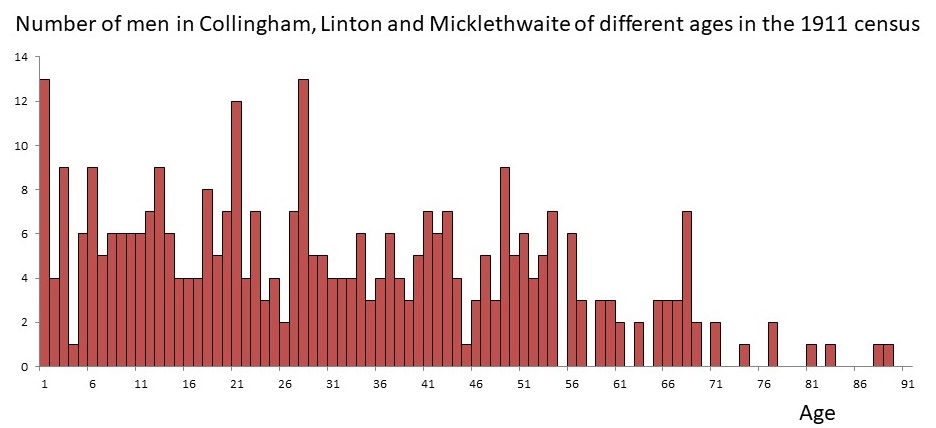THE VILLAGERS OF COLLINGHAM AND LINTON WHO SERVED IN WORLD WAR ONE
COLLINGHAMANDDISTRICTWARARCHIVE.INFO
 CONTACT
CONTACT
Collingham and Linton before the War
The village and civil parish of Collingham lies 2 miles (3 km) south east of Wetherby in West Yorkshire, on the River Wharfe. The current population (2011 census) is 2,991. Across the Wharfe, on its north bank, lies the smaller village of Linton. Before World War 1, Micklethwaite (now part of Wetherby) formed a part of the Collingham parish.
The 1911 census - 2nd April 1911
On the night of 2nd/3rd April 1911, a Census of England, Wales, the Channel Islands and the Isle of Man was taken. This was the last census before the First World War and so gives a useful comparison of the village size and also a list of the village's potential soldiers for the 1914-18 conflict. The census collected detailed information on the people who spent the night in each household, including their names, marital statuses, ages, occupations and birthplaces. It therefore forms an important record in trying to trace the men and women who may have fought in the War.
Analysis of the 1911 census shows that the population of the three villages was 729 people in 175 households, made up of 338 males and 391 females (see below). This census gives us a snapshot of the distribution of men in the village about three years before the War. But how many of these men would have been of military age?
| Place | No. Houses | Males | Females | Total |
| Collingham | 125 | 222 | 279 | 501 |
| Linton | 34 | 83 | 84 | 167 |
| Micklethwaite | 16 | 33 | 28 | 61 |
| Totals | 175 | 338 | 391 | 729 |
Later in the war, when conscription was introduced, all those men who had been born between 1875 and 1897 were deemed to be eligible for service, so it is interesting to see approximately how many men in the 1911 census were born in this age range. These men would have been aged between 14 and 36 in 1911, but we know of a number of men who lied about their ages to served, so we have looked at those aged 12 to 43. Analysis of the age distribution (see below) suggests that there were 104 males aged between 12 and 43, who might therefore be around military age during the war and who might form the recruits for the services from the villages. However the census was taken in 1911, and men moved into the village during the years between the census and war's start in 1914, and of course the census only identifies those who made their home in the villages, not those who worked here.

The following graph shows the men in the village on the 1911 census and identifies whether they served in the Great War. At the time of the 1911 census there were 13 men who can be identified as only temporary residents (lodgers and boarders).

The 1913 and 1914 electoral rolls
These electoral rolls for Collingham, Linton and Micklethwaite are some of the more complete lists of men in the villages just prior to World War 1. However these lists provide a far from complete list of villagers.
The 1884 Representation of the People Act increased the number of people eligible to vote, and hence the number of people who would appear on the electoral rolls. However there was far from universal suffrage. This new Act extended the number of voters to now include men who were a £10 occupier were now able to vote, as well as men inhabiting a dwelling house as an employee whose employer did not live there. However women were not generally voters, and even after those changes only about 60% of adult males appear on the rolls. However the 1913 and 1914 rolls are valuable lists of villagers.Other sources
Sadly no list of villagers who served has survived. The Collingham Parish Magazine provides a few names of those who had volunteered in 1914, but the list appears not to have been updated and has not survived - we are left to try to trace the names and histories of the villagers who served in World War 1 and the rest of this site tells some of their stories that we have pieced together.